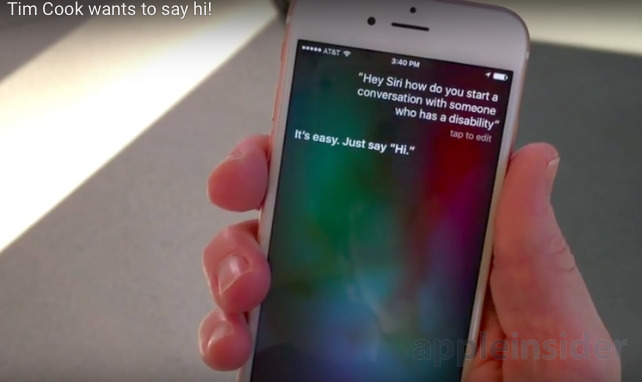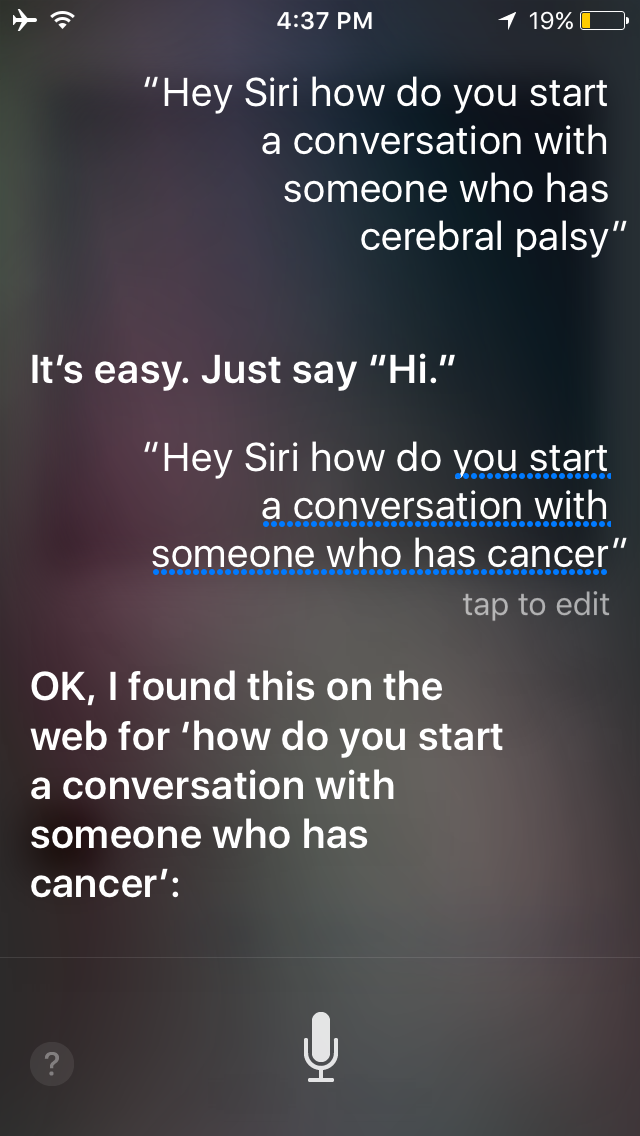Tim Cook recruits Siri for advice in Cerebral Palsy Foundation "Just Say Hi" campaign
Apple's chief executive Tim Cook has joined a series of celebrities adding their voice to a new Cerebral Palsy Foundation campaign designed to spark conversations with people with disabilities— in a spot that seeks advice from Siri.
Cook's video, shared on the CPF website as well as on the group's free iOS App states, "At Apple, we believe that inclusion inspires innovation, diversity gives us strength. And that includes people with disabilities."
The CPF campaign, intended to break down barriers to communicating with people who have a disability, suggests that people "just say hi" to start a conversation.
In Cook's video, he says, "it's easier than you think, but don't take my word for it." He then asks his iPhone 6s, "Hey Siri, how do you start a conversation with someone who has a disability?"
Siri responds, "It's easy. Just say 'Hi.'"
The video— captured at Apple's Cupertino campus (apparently at its nearby glass modernist cafeteria, featuring a design similar to the Campus 2 site now nearing completion)— cuts from Cook to Siri's response on the iPhone display, revealing that the video was also shot with an iPhone 6s, as is apparent in the screen's reflection (above). The phone also suggests that Cook uses AT&T and opted for Rose Gold.
"There you go," Cook says. "Reach out to someone with a disability. You can start by just saying Hi."
Cook, who is scheduled to receive the Robert F. Kennedy Center Justice & Human Rights Ripple of Hope Award tonight, joined a variety of CPF "Just Say Hi" video segments from TV personalities, athletes and others, including Microsoft's chief executive Satya Nadella (below).
CPF noted that "Satya's warmth permeates his communication." Nadella, however, relied on a standard video set and didn't reference any of the accessibility features of Windows, which are lagging significantly behind those of Apple's iOS.
Nadella was recently heckled on stage during a shareholder meeting by Microsoft's largest shareholder (and former chief executive) Steve Ballmer, who complained that Microsoft's universal apps strategy for getting more developers to bring their software to Windows phones and tablets "won't work," recommending instead that the company create a way to emulate Android apps.
However, Google's Android also significantly trails Apple in mobile software scope and quality, in addition to also lagging iOS in its accessibility features.
Apple drives accessibility
Apple has long invested in Accessibility features designed to make its products useable by people with disabilities. Last year, the president of the National Federation of the Blind noted that "Apple has done more for accessibility than any other company.""Apple has done more for accessibility than any other company" - National Federation of the Blind
Siri, Apple's intelligent assistant introduced on iPhone 4s in 2011, lets iOS users send messages, place phone calls, schedule meetings and other tasks with their voice. Siri can even to turn on accessibility features like VoiceOver.
As Cook demonstrated in his video, the newest iPhone 6s models now support an "always on" Hey Siri feature that lets users invoke the feature even without pressing a button.
Siri also helps fuel Apple's CarPlay initiative for hands free and "Eyes Free" navigation while driving, and plays a significant role in making the latests Apple TV easier and more compelling to use. Apple released new tvOS software today that expands Siri to enable voice search of Apple Music content.
In addition to Siri voice control, Apple has also developed a range of other accessibility features to help people with Cerebral Palsy and other disabilities that affect physical and motor control, including AssistiveTouch, Dictation and Predictive Text, as well as Touch Accommodation and Switch Control.
 Daniel Eran Dilger
Daniel Eran Dilger














 Amber Neely
Amber Neely
 Thomas Sibilly
Thomas Sibilly
 AppleInsider Staff
AppleInsider Staff
 William Gallagher
William Gallagher
 Malcolm Owen
Malcolm Owen
 Christine McKee
Christine McKee










11 Comments
This still doesn’t make up for the stonewalling Apple gave to people trying to get them to open up iOS enough to be used by people with physical disabilities just 3 years ago.
I just want Siri to be smarter already. This seems to be more about marketing honestly.


If you ask an even simpler version of the question you gets dumb answers like:
Why not revamp the whole system with answers on the fly? I appreciate this one disability question being addressed but again, it was just a special case.
see:
Well two posts,two negative responses re a post reaching out to ppl with disabilities. Must be AI.